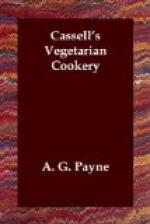* * * * *
STOCK.—Strictly speaking, in vegetarian cookery, stock is the goodness and flavouring that can be extracted from vegetables, the chief ones being onion, celery, carrot, and turnip. In order to make stock, take these vegetables, cut them up into small pieces, after having thoroughly cleansed them, place them in a saucepan with sufficient water to cover them, and let them boil gently for several hours. The liquor, when strained off, may be called stock. It can be flavoured with a small quantity of savoury herbs, pepper, and salt, as well as a little mushroom ketchup. It can be coloured with a few drops of Parisian essence, or burnt sugar. Its consistency can be improved by the addition of a small quantity of corn-flour. Sufficient corn-flour must be added not to make it thick but like very thin gum. In a broader sense, the water in which rice, lentils, beans and potatoes have been boiled may be called stock. Again, the water in which macaroni, vermicelli, sparghetti, and all kinds of Italian paste has been boiled, may be called stock. The use of liquors of this kind must be left to the common sense of the cook, as, of course, it would only be obtainable when these materials are required for use.
BROWN AND WHITE THICKENING, OR ROUX.—It is of great importance for vegetarians always to have on hand a fairly good stock of white and brown roux, as it is a great saving both of time and money. As roux will keep good for weeks, and even months, there is no fear of waste in making a quantity at a time. Take a pound of flour, with a spoonful or two over; see that it is thoroughly dry, and then sift it. Next take a pound of butter and squeeze it in a cloth so as as much as possible to extract all the moisture from it. Next take a stew-pan—an enamelled one is best—and melt the butter till it runs to oil. It will now be found that, although the bulk of the butter looks like oil, a certain amount of froth will rise to the top. This must be carefully skimmed off. Continue to expose the butter to a gentle heat till the scum ceases to rise. Now pour off the oiled butter very gently into a basin till you come to some dregs. These should be thrown away, or, at any rate, not used in making the roux. Now mix the pound of dried and sifted flour with the oiled butter, which is what the French cooks call clarified butter. Place it back in the stew-pan, put the stew-pan over a tolerably good fire, but not too fierce, as there is a danger of its burning. With a wooden spoon keep stirring this mixture, and keep scraping the bottom of the stew-pan, first in one place and then in another, being specially careful of the edges, to prevent its burning. Gradually the mixture will begin to turn colour. As soon as this turn of colour is perceptible take out half and put it in a basin. This is the white roux, viz., flour cooked in butter but not discoloured beyond a very trifling amount. Keep the stew-pan




